Lagerstätte
A Fossil-Lagerstätte (German: [ˈlaːɡɐˌʃtɛtə], from Lager 'storage, lair' Stätte 'place'; plural Lagerstätten) is a sedimentary deposit that exhibits extraordinary fossils with exceptional preservation—sometimes including preserved soft tissues.These formations may have resulted from carcass burial in an anoxic environment with minimal bacteria, thus delaying the decomposition of both gross and fine biological features until long after a durable impression was created in the surrounding matrix.The affinities of the shelly elements of conodonts were mysterious until the associated soft tissues were discovered near Edinburgh, Scotland, in the Granton Lower Oil Shale of the Carboniferous.Ediacara Hills 555 Ma South Australia The type location the Ediacaran period, and has preserved a significant amount of fossils from that time.Spence Shale 507 Ma Northeastern Utah, Southeastern Idaho, US A site known for its abundant Cambrian trilobites and the preservation of Burgess Shale-type fossils.[50] Wheeler Shale (House Range) 504 Ma Western Utah, US A world-famous locality known for its prolific agnostid and Elrathia kingii trilobite remains.Eramosa Lagerstätte ~425 Ma Ontario & New York (state) Known for preservation of both hard and soft bodied organisms in great detail, including early scorpions, eurypterids, agnathan vertebrates, and several other species.Bertie Group 422.9-416 Ma Ontario & New York State This limestone have produced thousands of fossil eurypterids, such as giant Acutiramus and well-known Eurypterus, as well as other fauna like scorpions and fish.The Fur Formation was deposited about 55 Ma, just after the Palaeocene-Eocene boundary, and its tropical or sub-tropical flora indicate that the climate after the Paleocene-Eocene Thermal Maximum was moderately warm (approximately 4-8 degrees warmer than today).London Clay 54–48 Ma England, UK Collected for close to 300 years, Plant fossils, especially seeds and fruits, are found in abundance.After almost becoming a landfill, strong local resistance eventually stopped these plans and the Messel Pit was declared a UNESCO World Heritage Site on 9 December 1995.Quercy Phosphorites Formation[191] 45-25 Ma Occitania, France This site qualifies as a lagerstätte because beside a large variety of mammals, birds, turtles, crocodiles, flora and insects, it also preserves the soft tissues of amphibians and squamates, in addition to their articulated skeleton in what has been called natural mummies.Florissant Formation 34 Ma Colorado, US A late Eocene (Priabonian) aged site that is noted for the finely preserved plant and insect paleobiota.


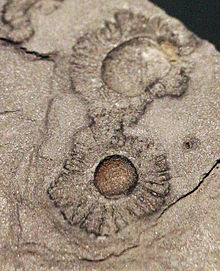






















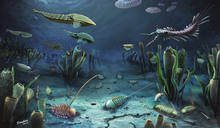



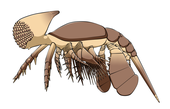











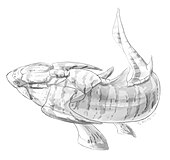























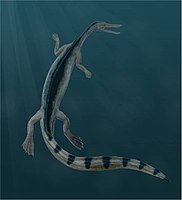










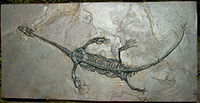


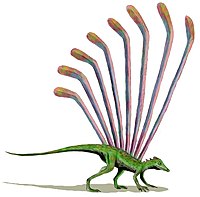





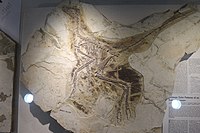













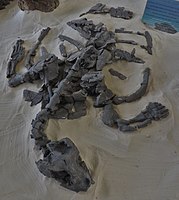




















































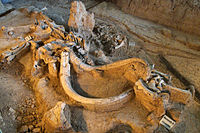



PaleontologyFossilizationTrace fossilMicrofossilFossil preparationIndex fossilList of fossilsList of fossil sitesList of transitional fossilsList of human evolution fossilsBiogeographyExtinction eventGeochronologyGeologic time scaleGeologic recordHistory of lifeOrigin of lifePaleoclimatologyTimeline of evolutionTransitional fossilAvian flightMulticellsFlagellaMammalian auditory ossiclesMosaic evolutionNervous systemsButterfliesCephalopodsCetaceansDinosaursFishesHumansInsectsMammalsMolluscsPlantsReptilesSea cowsSpidersIntroduction to evolutionCommon descentPhylogenyCladisticsBiological classificationHistory of paleontologyTimeline of paleontologyBiostratigraphyIchnologyInvertebrate paleontologyMicropaleontologyMolecular paleontologyPalaeoxylologyPaleobiologyPaleobotanyPaleoecologyPaleogeneticsPaleolimnologyPaleomycologyPaleoneurobiologyPaleopathologyPaleopedologyPaleotempestologyPaleozoologyPalynologySclerochronologyTaphonomyVertebrate paleontologyOpabiniaBurgess ShaleCambriansedimentaryfossilsanoxicgeologicalNeoproterozoicpresentMaotianshan shalesOrdovicianSoom ShaleSilurianWaukesha BiotaDevonianHunsrück SlatesGogo FormationCarboniferousMazon CreekMadygen FormationJurassicPosidonia ShaleSolnhofen LimestoneCretaceousYixianSantanaAgua NuevaTanis Fossil SiteEoceneFur FormationGreen River FormationMessel FormationMonte BolcaMioceneFoulden MaarAshfall Fossil BedsPlioceneGray Fossil SitePleistoceneNaracoorte CavesLa Brea Tar PitsPalaeontologistsoysterevolutionCambrian explosionArchaeopteryxSolnhofenEchinochimaeraBear Gulch LimestonesclerotizedpalaeoecologySimon Conway MorrisbiomineralizedconodontsOil ShalephylogeneticmetazoantaphonomicPhosphatization










